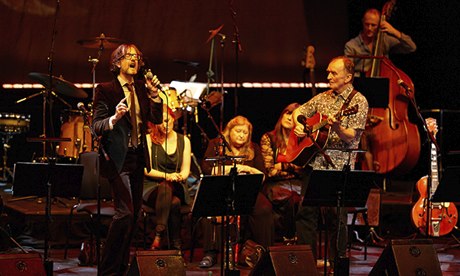
There were moist eyes backstage at the end of this historic, emotional concert, and with good reason. This was the first live performance of songs from a 1972 album by the late Lal and Mike Waterson, revived by an impressive cast dominated by remaining members of the celebrated Waterson family. On its release, Bright Phoebus upset many folk fans because it was new and experimental, rather than traditional. A good-quality version has never been available on CD. But it has gradually acquired cult status, and the Barbican crowd responded with standing ovations.
Lal and her brother Mike started out with those gutsy folk pioneers the Watersons and only began writing songs when the group split and their sister, Norma, went off to the West Indies. Martin Carthy (who would later join the revived Watersons and marry Norma) heard the songs and enthused about them to Richard Thompson. They would both perform on Bright Phoebus, which Thompson now says ''deserves to be a regular entry on the list of greatest albums of all time".
This show included all the album's songs (though not in the same order) along with other work by Lal and Mike, some of it never heard before. It was, inevitably, a wildly varied set because they had such different styles. Many of Mike's songs were quirky, pop-influenced singalongs, such as Rubber Band and Shady Lady, which opened and closed the show. The one example of his more thoughtful work was Jack Frost. Lal was very different: a painter and poet, influenced by Arthur Rimbaud, her strange and haunting songs were remarkable for their unusual structures and for what her niece Eliza Carthy has called "her dark poetic imagery".
The most memorable songs of the night were all by Lal. Her daughter Marry, who played a key role in this project and looks and sounds uncannily like her mum, provided a powerful, no-nonsense treatment of the first such song, Fine Horseman. Then Jarvis Cocker gave a compelling treatment of The Scarecrow, a dark and eerie piece about the seasons, while Bob Davenport, who sang on the original recording, appeared alongside Eliza for the chilling and surreal Child Among the Weeds. Thompson's daughter Kami sang Evon Our Darling (only recorded by Lal as a demo), while Norma was accompanied by her husband for a story of drink and survival, Red Wine Promises. It has taken far too long for these remarkable songs to be heard. So now, will those with the master tapes kindly re-release the original album?
• Did you catch this gig – or any other recently? Tell us about it using #Iwasthere

